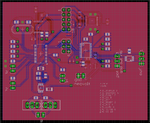randomshinichi
Newbie level 6
I've been reworking my PCB so that the ground plane on the top layer (with all the critical signals) can reach between traces more of the time, effectively having the guard trace accompany the signal trace as long as possible. The question is, the other side of my PCB is mostly a contiguous ground plane, so is this really necessary?
